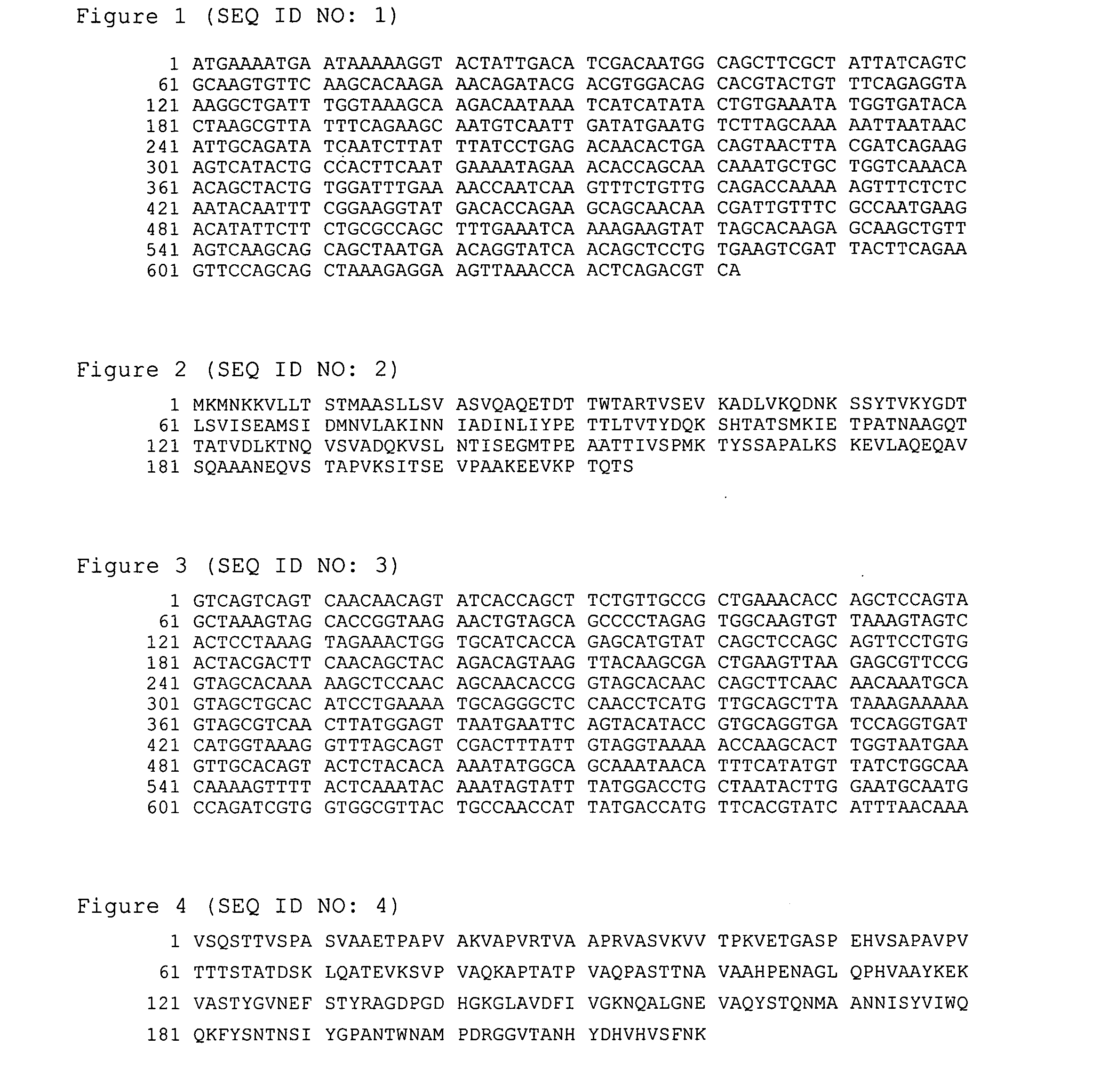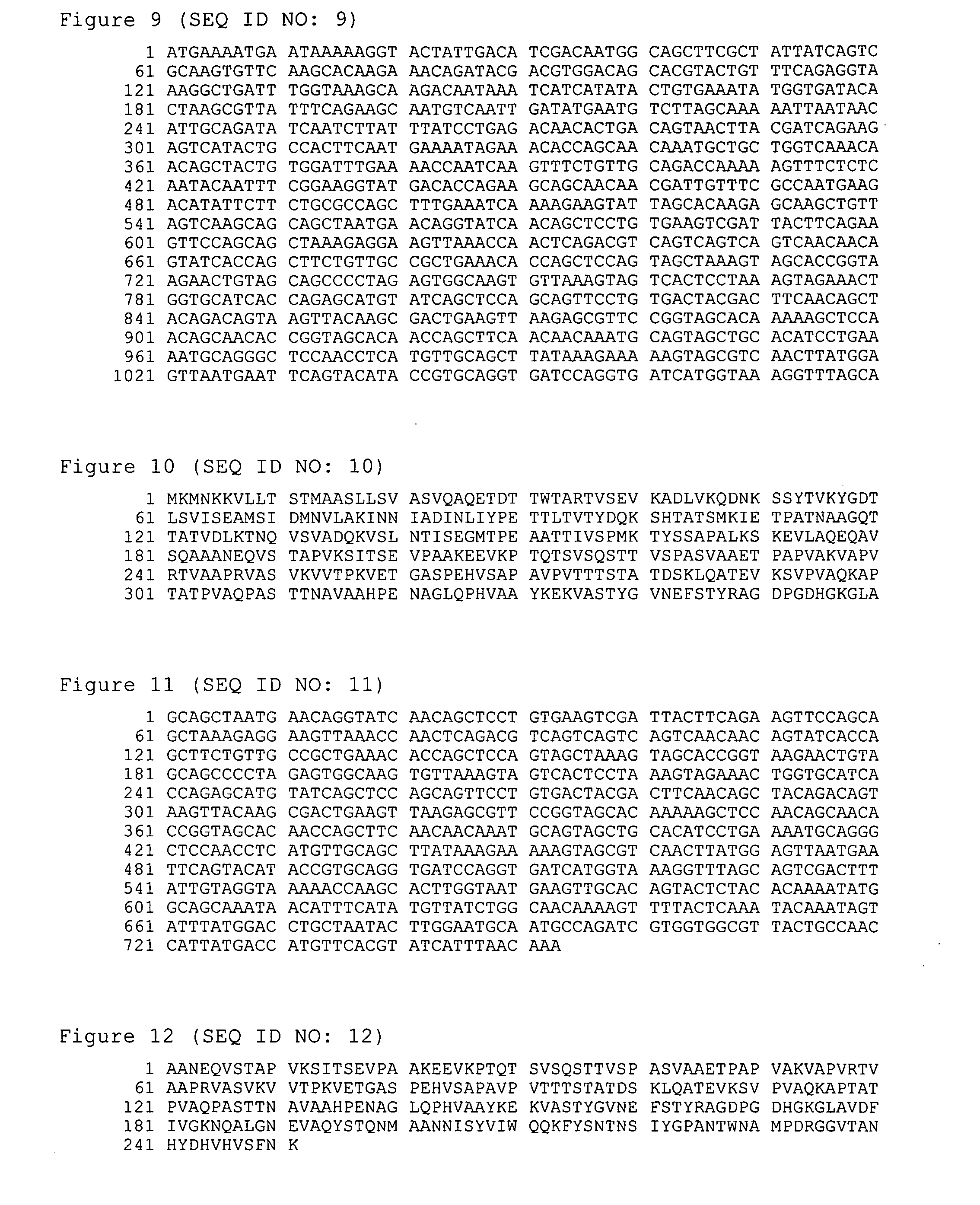Group b streptococcus antigens
a streptococcus and antigen technology, applied in the field of polypeptides, epitopes and antibodies, can solve the problems of high morbidity and mortality, death, disability, and the risk of postpartum infection of expectant mothers exposed to gbs
- Summary
- Abstract
- Description
- Claims
- Application Information
AI Technical Summary
Benefits of technology
Problems solved by technology
Method used
Image
Examples
example 1
[0166] This example describes the cloning of truncated sip gene products by polymerase chain reaction (PCR) and the expression of truncated molecules.
[0167] Fragments of Group B streptococcal sip (SEQ ID NO: 42 from PCT WO 99 / 42588) gene were amplified by PCR (DNA Thermal Cycler GeneAmp PCR system 2400 Perkin Elmer) from genomic DNA of serotype I a / c Group B streptococcal strain C388 / 90 using pairs of oligonucleotide primers that contained base extensions for the addition of restriction sites and methionine (Table 1). The methionine was added for C-terminal and internal truncated Sip polypeptide. PCR products were purified from agarose gel using a QIAquick gel extraction kit from QIAgen following the manufacturer's instructions, and digested with restriction endonucleases. The pET vector (Novagen, Madison, Wis.) was digested with the same endonucleases and purified from agarose gel using a QIAquick gel extraction kit from QIAgen. The digested PCR products were ligated to one of the...
example 2
[0169] This example illustrates the reactivity of the His-tagged truncated Sip recombinant polypeptides with antibodies present in human sera.
[0170] As shown in Table 3, ΔSip-2 (215-434), ΔSip-3 (146-434), and ΔSip-4 (272-434) His-tagged recombinant polypeptides were best recognized in immunoblots by the antibodies present in the pool of human sera. This is an important result since it clearly indicates that humans which are normally in contact with GBS do develop antibodies that are specific to the C-terminal portion of the polypeptide (aa 215-434). These particular human antibodies might be implicated in the protection against GBS infection.
TABLE 3Reactivity in immunoblots of antibodies presentin human sera with truncated Sip polypeptides.Purified recombinantpolypeptide I.D.1Reactivity with human sera2Sip (1-434)+++ΔSip-1 (1-214)+ΔSip-2 (215-434)+++ΔSip-3 (146-434)+++ΔSip-4 (272-434)++ΔSip-5 (1-360)+
1His-tagged recombinant polypeptides produced and purified as described in Exam...
example 3
[0171] This example illustrates the binding at the surface of intact GBS cells of antibodies directed against truncated Sip polypeptides.
[0172] Bacterial cells were grown to early exponential phase in Todd-Hewitt broth (THB: Difco Laboratories, Detroit, Mich.) and the OD600, was adjusted with THB to 0.15 (corresponding to ˜108 CFU / ml). Ten μl of mouse truncated Sip-specific or control sera were added to 1 ml of the bacterial suspension. The tubes containing the bacterial and sera suspensions were incubated for 2 h at 4° C. under gentle rotation. Samples were washed 3 times in blocking buffer [phosphate-buffered saline (PBS) containing 2% (wt / vol) bovine serum albumin (BSA: Sigma Chemical Co., St. Louis, Mo.)], and then 1 ml of goat fluorescein (FITC)-conjugated anti-mouse IgG+IgM (Jackson ImmunoResearch Laboratories, Mississauga, Ontario, Canada) diluted in blocking buffer was added. After a further incubation of 60 min at room temperature, samples were washed 3 times in blocking b...
PUM
| Property | Measurement | Unit |
|---|---|---|
| Fraction | aaaaa | aaaaa |
| Fraction | aaaaa | aaaaa |
| Fraction | aaaaa | aaaaa |
Abstract
Description
Claims
Application Information
 Login to View More
Login to View More - R&D
- Intellectual Property
- Life Sciences
- Materials
- Tech Scout
- Unparalleled Data Quality
- Higher Quality Content
- 60% Fewer Hallucinations
Browse by: Latest US Patents, China's latest patents, Technical Efficacy Thesaurus, Application Domain, Technology Topic, Popular Technical Reports.
© 2025 PatSnap. All rights reserved.Legal|Privacy policy|Modern Slavery Act Transparency Statement|Sitemap|About US| Contact US: help@patsnap.com



